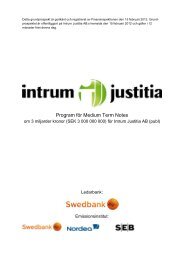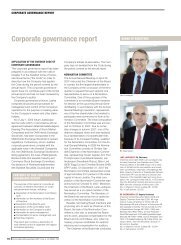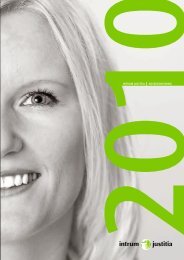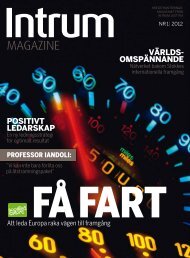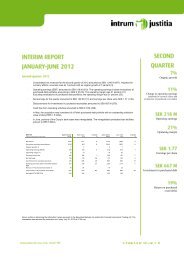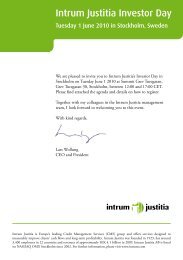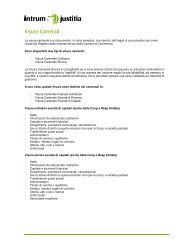ANNUAL REPORT INTRUM JUSTITIA A N N U A L R EP O R T 2 0 ...
ANNUAL REPORT INTRUM JUSTITIA A N N U A L R EP O R T 2 0 ...
ANNUAL REPORT INTRUM JUSTITIA A N N U A L R EP O R T 2 0 ...
Create successful ePaper yourself
Turn your PDF publications into a flip-book with our unique Google optimized e-Paper software.
NET fINANCIAL ITEMS<br />
The net financial expense amounted to SEK<br />
–91.3 M (–79.8), including an exchange rate difference<br />
of SEK –8.6 M (4.8). The net interest expense<br />
was affected by higher market interest rates.<br />
TAXES<br />
The Group lost a tax dispute in Finland and has<br />
paid and expensed an additional tax payment for<br />
1999 – 2002 of SEK 41.8 M including fees of<br />
SEK 21.5 M. The company has appealed the fees.<br />
During the year the Group’s Swedish subsidiary<br />
received a tax rebate of SEK 14.0 M which<br />
was taken up as an expense in 2009.<br />
The tax expenses for the year , excluding oneoff<br />
items amounted to 24.9 percent (25.1). The<br />
tax expense for the group is dependent in part<br />
on how the earnings break down between subsidiaries<br />
in different countries with different tax<br />
rates. As a whole, the assessment that the tax expense<br />
will be around 25 percent of pre-tax earnings<br />
still stands.<br />
The average tax expense depends in part on<br />
the Group’s ability to achieve positive earnings<br />
in the countries where pre-tax earnings<br />
are negative. In some cases loss carryforwards<br />
from previous years exist and can be used to<br />
offset future profits. At the end of 2010 the<br />
Group had loss carryforwards totaling SEK<br />
2,289.2 M (1,962.6). Of this amount, SEK<br />
129.5 M (287.7) is the basis for deferred tax<br />
assets recognized in the balance sheet because<br />
the Group has concluded that the loss carryforwards<br />
can be used to offset taxable profit<br />
over the next few years.<br />
For more information about the Group’s<br />
taxes, see Note 8.<br />
RECLASSIfICATION IN<br />
THE fINANCIAL STATEMENTS<br />
In 2010 a correction was made to the reporting<br />
of client funds in the Group’s subsidiary<br />
in the Netherlands. Since the first quarter of<br />
2009 this company had based its classifications<br />
in the balance sheet on partially incorrect information<br />
which was corrected in 2010. The<br />
effect was a reclassification in the balance sheet<br />
that affects the lines: Other receivables, Client<br />
funds and Current liabilities to credit institutions.<br />
The comparison figures from 2009 have<br />
been restated based on the correction and the<br />
effect on the balance sheet as of December 31,<br />
2009 is that Clients funds on the assets side<br />
and the liabilities side each increased by SEK<br />
87.4 M and Other current receivables and Current<br />
liabilities to credit institutions also each<br />
increased by SEK 87.4 M<br />
A gross amount recognised in the income<br />
statement relating to repayments of expenses<br />
in the Netherlands was also corrected. The correction<br />
has not effected the operating earnings.<br />
If the new principle had been applied in 2009,<br />
the revenues for the year would have been SEK<br />
64.4 M lower than reported.<br />
CASH fLOW AND INVESTMENTS<br />
Cash flow from operating activities improved<br />
during the year to SEK 1,629.8 M (1,433.4).<br />
Disbursements during the year for purchased<br />
debt investments amounted to SEK 1,049.6 M<br />
(870.6).<br />
During the year SEK 145.5 M (235.9) was<br />
invested in tangible and intangible fixed assets.<br />
SEK M<br />
2,000<br />
1,600<br />
1,200<br />
800<br />
400<br />
0<br />
874<br />
1,013<br />
1,261<br />
Cash flow from operating activities<br />
Research and development<br />
The Group is not engaged in any research and<br />
development other than the development of<br />
its IT systems. Investments for the year largely<br />
relate to hardware and software for IT systems,<br />
mainly for production. Technological development<br />
is rapid and, if used in the right way,<br />
new technical solutions can improve efficiency<br />
in the management of client receivables and<br />
use of the Group’s databases. As demand for<br />
customized IT solutions grow, it is of strategic<br />
importance for Intrum Justitia to constantly<br />
adapt to changes in demand. In 2009 the production<br />
system for collections in Switzerland<br />
and Austria was upgraded and was successfully<br />
implemented in 2010 in Germany as well to<br />
achieve efficiency improvements.<br />
fINANCING<br />
Net debt as of December 31, 2010 amounted<br />
to SEK 2,193.3 M, compared to SEK 2,069.0<br />
M as of December 31, 2009. The net debt as<br />
of December 31, 2009 was restated from the<br />
previously reported SEK 1,981.6 M in connection<br />
with the reclassification in the financial<br />
statements described above, whereupon the<br />
net debt/equity ratio at the close of 2009 was<br />
changed from 77.7 percent to 81.2 percent.<br />
Shareholders’ equity including minority interest<br />
amounted to SEK 2,576.6 M, compared<br />
to SEK 2,548.9 M at the beginning of the year.<br />
As of December 31, 2010 the Group had<br />
liquid assets of SEK 507.1 M, compared to<br />
SEK 491.4 M the previous year. Unutilized<br />
credit facilities amounted to SEK 233.7 M,<br />
compared to SEK 849.7 M the previous year.<br />
1,433<br />
1,630<br />
06 07 08 09 10<br />
SEK M<br />
3,000<br />
2,500<br />
2,000<br />
1,500<br />
1,000<br />
500<br />
0<br />
1,464<br />
1,527<br />
2,348<br />
06 07 08 09 10<br />
Net debt<br />
Board of Directors’ report<br />
The Group’s syndicated loan of EUR 310 M<br />
expiring in February 2010 was repaid in January<br />
and replaced by a new syndicated loan of<br />
the same amount expiring in March 2013.<br />
Most of the Parent Company’s and the<br />
Group’s external borrowing has been arranged<br />
in foreign currencies since February 2009 as a<br />
means of hedging against net exposure in the<br />
Group’s foreign subsidiaries.<br />
RISK AND RISK MANAGEMENT<br />
Intrum Justitia defines risk as all factors which<br />
could have a negative impact on the ability of<br />
the Group to achieve its business objectives.<br />
All economic activity is associated with risk.<br />
In order to manage risk in a balanced way, it<br />
must first be identified and assessed. Intrum<br />
Justitia conducts risk management at both<br />
a Group and company level, where risks are<br />
evaluated in a systematic manner.<br />
Intrum Justitia’s risk management covers<br />
strategic risks, operational risks, risk relating to<br />
the regulatory environment and financial risks.<br />
The following summary is by no means<br />
comprehensive, but offers examples of risk factors<br />
which are considered especially important<br />
for Intrum Justitia’s future development.<br />
Strategic risks<br />
Cyclicality<br />
The CMS industry, while in no way unaffected<br />
by economic conditions, has historically, in<br />
Intrum Justitia’s experience, been less affected<br />
by economic fluctuations than many other sectors.<br />
This is due to stabilizing forces in both<br />
good times and bad. For Intrum Justitia, the<br />
effects of economic conditions in individual<br />
markets are also reduced by the Group’s geographic<br />
diversity.<br />
During periods of economic growth the<br />
number of business transactions rises, as does<br />
lending in general and thus the number of<br />
invoices in circulation. Payment capacity also<br />
increases and consequently the percentage of<br />
invoices that become overdue and go to collections<br />
declines. In absolute terms, however, the<br />
number of overdue receivables and collection<br />
cases usually rises at the same time as improved<br />
payment capacity makes it easier to collect debt.<br />
2,069<br />
2,193<br />
37




